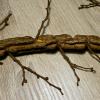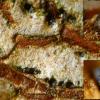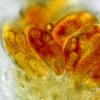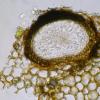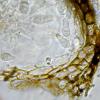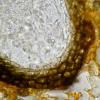
16-05-2020 09:55
 Zuzana Sochorová (Egertová)
Zuzana Sochorová (Egertová)
Hi, this very little pyrenomycete was found in Mo

15-05-2020 09:06
Stefan BlaserHello everybody, I found this one on a "phlepioid

15-05-2020 16:29
 Andgelo Mombert
Andgelo Mombert
Bonjour, Sur branche morte d'Abies alba de 1 cm d

15-05-2020 09:36
Ibai Olariaga IbargurenHi there, This is a fungus that I found on bark o

13-05-2020 22:59
 Marian Jagers
Marian Jagers
Cultured on a Knopper gall (Knopper gall found in

14-05-2020 09:22
Me mandan esta muestra en seco de Galicia, recol

13-05-2020 11:16
Valencia Lopez Francisco JavierHola amig@sHe recolectado estos discomicetes sp en
Pyrenomycete causing deformation on Corylus twigs?
Björn Wergen,
02-02-2014 20:12
 Hi friends,
Hi friends,I have some Corylus twigs here with a deformation caused by small, black pyrenomycetes, which are growing on the deformations, while the twig is still living.
Pseudothecia 0,2-0,35mm, 1/2 embedded into the surface and growing freely later, black, pyriforme, smooth, without ostiolus.
Spores are 20-24x8-10µm, asymmetrical, upper cell broader, generally with three septations, smooth, hyaline. Asci with 8 spores, somewhat saccate, broadest in the middle-lower region, IKI- (red), bitunicate, no stalk, 55-65x17-22µm, without pseudoparaphyses/periphyses. Wall consisting of a 12-15µm thick region of dark brown parenchymatous cells and a ~10µm thick region with paler to hyaline, compressed cells.
Any idea? I thought about Leptosphaerulina, but I did not find any species with the described features.
regards,
björn
Jaklitsch Walter,
02-02-2014 20:49
Re : Pyrenomycete causing deformation on Corylus twigs?
Hi Björn,
based on the image the host is Ulmus minor due to the cork wings (or strips) and alternating twigs. The wings are dead.
The fungus is apparently Saccothecium sepincola, typically occurring on Rosa, although the spore size you give is unusually large.
Regards, Walter
based on the image the host is Ulmus minor due to the cork wings (or strips) and alternating twigs. The wings are dead.
The fungus is apparently Saccothecium sepincola, typically occurring on Rosa, although the spore size you give is unusually large.
Regards, Walter
Björn Wergen,
02-02-2014 21:02

Re : Pyrenomycete causing deformation on Corylus twigs?
Hi Walter,
really Saccothecium sepincola? I thought about that species, but it is described mostly with more than 4 septations. Quite curious...however, thanks for your opinion :)
regards,
björn
really Saccothecium sepincola? I thought about that species, but it is described mostly with more than 4 septations. Quite curious...however, thanks for your opinion :)
regards,
björn
Jaklitsch Walter,
02-02-2014 21:24
Re : Pyrenomycete causing deformation on Corylus twigs?
image 3 in the middle shows an ascospore with 5 septa, if I see that correctly
The fasciculate asci are also typical.
W.
The fasciculate asci are also typical.
W.
Alain GARDIENNET,
02-02-2014 22:41
Re : Pyrenomycete causing deformation on Corylus twigs?
Hi Björn,
Again Walter is right, I think.
All features fit well with S. sepincola (particularly hamathecium). Generally, it's given on Rosa. But I have already found it on Rubus sp. and Cornus sanguinea.
Alain
